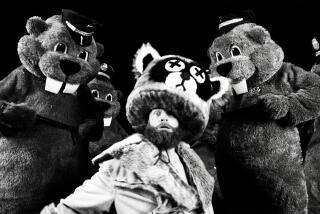A generation later, ‘Rocko’s Modern Life’ and ‘Invader Zim’ are still ahead of their time
Cartoon characters are great to have under contract. They don’t age; they don’t argue. They are the most reusable of beings. Mickey Mouse has had a 90-year career in show business — so far. There were years in suspended animation, as it were, as lean times for animation waited for better ones. But the Mouse is still in the house.
Younger viewers, raised on a steady diet of Pixar, Disney and Dreamworks Animation, may be astonished to learn there were years in which cartoons were hardly being made, in America at least. It was on the ropes both as a business and an art.
This began to change with the appearance of shows like Ralph Bakshi’s “The New Adventures of Mighty Mouse” (CBS, 1987), John Kricfalusi’s “The Ren & Stimpy Show” (Nickelodeon, 1991), and Joe Murray’s “Rocko’s Modern Life” (Nickelodeon, 1993), creator-driven projects that were at once historically conscious, forward-looking and fringe. There being no clear career path in cartooning, the field was, almost by definition, dominated by outsiders, weirdos and nerds.
Now, Nickelodeon, via Netflix, has brought back two of its more eccentric old properties, for what might be billed as “one night only,” if you couldn’t stream them whenever and as much as you wanted. “Rocko’s Modern Life: Static Cling,” debuted Aug. 9; Friday brings Jhonen Vasquez’s feature-length “Invader Zim: Enter the Florpus.” (An earlier Nick revival, “Hey Arnold! The Jungle Movie,” aired in 2017.) Each has been written or co-written by its creator, reunites the original cast and stays true to its voice and aesthetic — neither has been retooled, like the rebooted “Powerpuff Girls,” for a “modern audience,” or needed to be. (Like all great cartoons, they are not particularly for children.)
Whatever combination of inspiration and algorithm, brand exploitation and fan service, has conspired to resurrect these oddball series — both battled the censors, and “Zim,” though almost immediately a cult favorite, was taken off the air in the midst of its second season — each revival is a successful and satisfying work of animated art. They are crass only in their humor.
“Rocko’s Modern Life” picks up where the series ended in 1996. Rocko, a wallaby; Filburt, a turtle; Heffer, a cow; and Rocko’s dog, Spunky (a non-talking dog, like Pluto), have been stuck in space for 20 years, “with no cable TV and no clean undergarments,” having lost the remote control for the errant rocket that carried their house into space. (It is finally discovered between Heffer’s buttocks.)
“I don’t think we’re in the ’90s anymore,” says Rocko, upon reentry, and there are jokes about kale, drones, selfies, virtual reality, computer animation, online shopping — a delivery truck bears the legend “Impulse-o-shop.com. Things you don’t need delivered fast” — Starbucks, YouTube, gluten-free diets and nostalgia itself. The special, like the series, offers a critique of consumerist economics — “modern life,” yo. During the climax, as money from the Conglom-O corporation (its original slogan, “We Own You,” is now “We Still Own You”) rains down upon the citizens of O-town, someone cries, “This is the fruit of capitalist redundancy.” Though I have not worked out exactly what that means, it is not the sort of thing you hear in most cartoons.
“Rocko” was always self-aware, and “Static Cling” goes all in, with a metafictional recounting of its own rebirth. It’s about reviving “The Fatheads,” Rocko’s own favorite cartoon, and it touches explicitly on the intersection of fandom and commerce such revivals represent: “’90s cartoon solves problem$,” runs a chyron in one news report. (“Local man misses important plot point looking for hidden jokes,” runs another.) In a plot point much commented on, the “Fatheads” creator, a cane toad formerly known as Ralph Bighead and played by Murray himself, is now named Rachel, occasioning a sweet line from her mother, Bev Bighead: “I think it’s great what Rachel has done. I’m sure she’s much more comfortable with herself. Plus, I just found these shoes in her size — aren’t they adorable?” Mothers of daughters may recognize themselves.
There are also fart jokes.
“Invader Zim,” the 27 previous episodes of which are available on Hulu, is a dark, sometimes disgusting series about a megalomaniacal paranoid alien living in disguise (as an elementary school student) on Earth. Zim, accompanied by GIR — an imperfectly functioning robot assistant with the personality of a hyperactive child and usually dressed as a dog — believes he has been sent to prepare the planet for invasion, but he has in fact been exiled by his superiors for being insufferable. Only classmate Dib Membrane recognizes Zim for the alien he is, and fails repeatedly to convince anyone else of the threat that Zim theoretically poses. (Incompetence usually saves the day.)
As we rejoin the story, after an unspecified long-but-not-very-long time, Zim has disappeared — in fact, he’s been hiding in a toilet — while Dib, confining himself to his room, monitors surveillance cameras with such obsession that he has become literally “more chair than man.” And then, suddenly, Zim appears on Dib’s surveillance camera.
“He’s back. And he’s doing stretches! Nobody stretches like that unless he’s warming up for evil.”
This consists of kicking over trash cans and “switching people’s mail around.”
“That’s illegal!” Dib cries, as they meet again.
“I’m reading someone’s newspaper,” Zim cackles. “I don’t pay for a subscription!”
“Nobody reads newspapers anymore,” Dib replies, “but no! Stop!”
Things do get more evil after that, and positively apocalyptic.
The show was so far ahead of its time that it still feels ahead of its time. “Zim” is fast moving and violent, not so much in the “Itchy & Scratchy” sense — though there is a bit of that — as in the madness of its villains and heroes, the speed with which it whips you around, and the general feeling of filth and decay that informs the characters and their environment. (Nickelodeon fielded Vasquez from the comics world, where he was known for the series “Johnny the Homicidal Maniac.”) It’s a superior action show, when it goes that way — Vasquez and supervising producer Breehn Burns (“Bravest Warriors”) also do well with quieter comedy — and the set pieces here, which integrate traditional 2D animation and CGI, feel big and effective. The drawing itself is sharp and angular in a way that remains little imitated, and was reportedly difficult to animate.
The revival’s feature length has fractionally slowed the pace, just as the new widescreen format — that’s how ancient the original cartoons are; they never made it out of the old standard format — makes it feel less cramped and claustrophobic. Technological advances in cartoon-making and television viewing make both “Rocko” and “Zim” look a little cleaner, a little more detailed than before. These improvements are not fatal.
‘Rocko’s Modern Life: Static Cling’
Where: Netflix
When: Any time
Rating: TV-Y7 (may be unsuitable for children under the age of 7)
‘Invader Zim: Enter the Florpus’
Where: Netflix
When: Any time
Rating: TV-Y7 (may be unsuitable for children under the age of 7 with an advisory for fantasy violence)
More to Read
The complete guide to home viewing
Get Screen Gab for everything about the TV shows and streaming movies everyone’s talking about.
You may occasionally receive promotional content from the Los Angeles Times.






